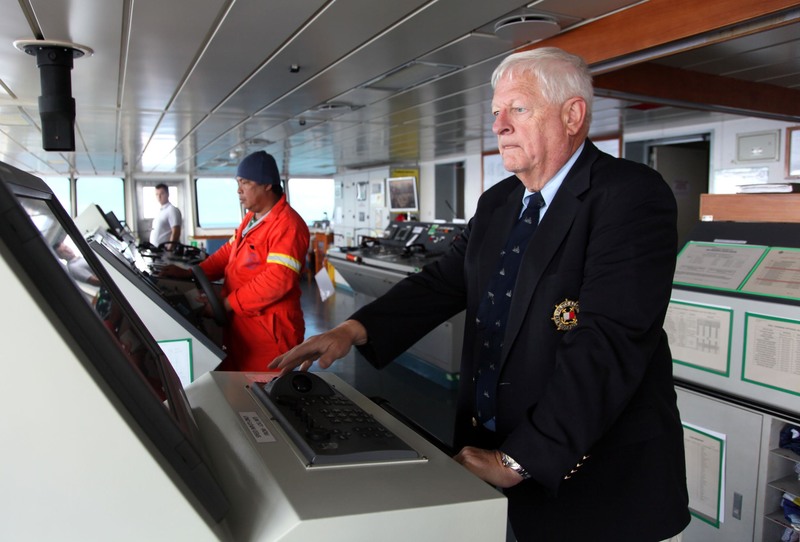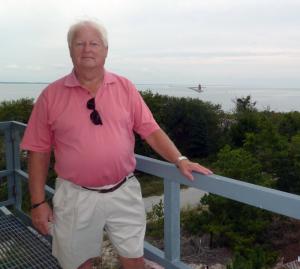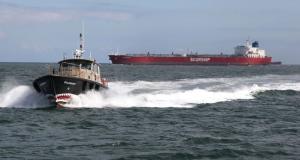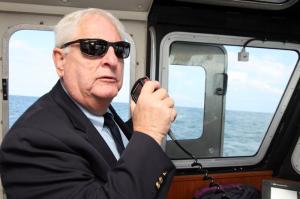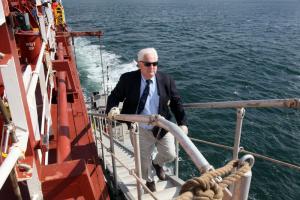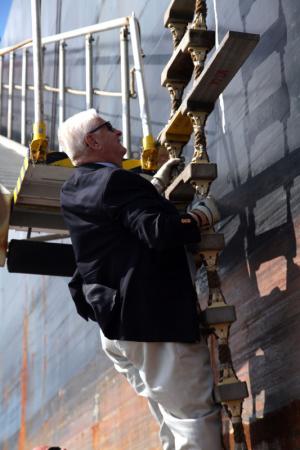Capt. Dick Buckaloo III: A man whose ship came in
We’re driving down Pilottown Road as Richard “Dick" Buckaloo III shows me around Lewes, his hometown. He talks about community pride, the town’s place in history and its rich maritime heritage.
This coastal settlement was founded by the Dutch in 1631, and generations of river pilots once lived along this stretch of road. Buckaloo points out the small home where he grew up in the 1950s, a stone’s throw from the Lewes-Rehoboth Canal. “I used to fish there almost daily, rain or shine,” he says, smiling at the memory.
Buckaloo shares his deep love for the sea and a boyhood dream of becoming a Delaware River pilot. It was his father’s dream too. “He never had the opportunity, but he gave it to me," he says.
After 47 years, Buckaloo, the senior pilot of the Pilots Association for the Bay and River Delaware, will officially retire March 1. His last ship date was Dec. 5, 2014.
For centuries, these little-known pilots have guided commercial vessels through the Delaware Bay and River's shoal-ridden and congested waterways, bringing them safely to nearby ports. Buckaloo’s father was a waterman who settled in Lewes in the early 1930s and married a local girl. “He always wanted to be a river pilot and was friends with all the neighborhood pilots. But years ago, you had to be born into the profession or have connections. Nepotism was rampant,” he tells me.
So, as a young boy, Buckaloo knew his chances of becoming a pilot were slim. Yet he had a gleam of hope and clung to his dreams. He was intrigued by the sea’s mystery, the oceangoing ships, and the seafaring stories that surrounded him. He wasn’t daunted by the perilous tales of the “Jacob’s ladder,” a notorious runged rope ladder that pilots climb when embarking and disembarking ships.
In the early 1960s, Buckaloo’s “connection” came when his father was elected to the Delaware River Pilots Commission. In 1964, at age 19, the younger Buckaloo saw his dream moved toward reality with an extensive four-year apprenticeship, followed by significant sea time and fueled by pure grit. He moved through the restricted levels (limited size and weight of ships) until he became a first-class pilot. Today, he is the senior member among the association's 72 pilots, including his son, Bill Henry. His grandson Christopher is currently enrolled at the State University of New York Maritime College and will join the maritime regiment in the fall.
Crucial to commerce
River pilots have always been crucial to the commerce that flows across the Atlantic Ocean, and they’re even more vital in today’s global economy. Each year, they guide thousands of ships to ports and terminals along the Delaware River, a 120-mile bendy stretch of water that supports Delaware, New Jersey and Pennsylvania. All foreign ships, and some U.S. ships, must hire a pilot when arriving to and departing from their port of call.
While ship captains are familiar with the open sea, they know nothing of the potential dangers that often lurk in local waterways, according to Buckaloo. River pilots, however, know the area’s shifting channels, the currents, tides and shoals like they know the streets in their own neighborhood. “We’re trained to maneuver through these obstacles and make quick decisions on a proper course. Even a minor error could cost lives or cause an environmental disaster. Our job is to bring the ships in safely,” he says.
The association is headquartered in Philadelphia, and the Pilot Station and Maritime Exchange Tower are located in Lewes. We drive out to the tower which rises above the sand dunes near the point at Cape Henlopen State Park. Along the way, I ask him about the love affair people often have with the sea - the image of a smooth, calming blue upon the horizon, the sun glittering off sails, the waves pounding the shore like a heartbeat. “Yes, there’s some of that,” he assures. “Every day is different, but on some days everything just clicks - beautiful weather, blue sky, perfect timing; it’s effortless.”
Still, early on, Buckaloo learned the harsh realities of being a river pilot. No matter how much you love the sea, it doesn’t always love you back. He’s boarded ships through winter blizzards, hurricane-force winds, and fog so dense that radar was needed to find the ship. “Fog has no season. Nights are the worst, and 75 percent of our trips are at night so the ships can make port and be unloaded in normal hours,” he says.
I mention the shipwrecks, explosions and other sea disasters I’ve read about, and ask him if he’s ever faced great danger. “Extreme weather conditions and dangerous cargo can be an issue, but I don’t dwell on it,” he says, reluctant to talk further about the hazards of his profession. But I’m curious and press him about his worst moments at sea.
A harrowing winter storm
He recalls an historic winter storm that blanketed the East Coast. “It was February 1979. The ship's name was Hickory. I boarded around 2 a.m. in a light rain. Visibility was about a mile. We like to have more than that, especially in those days when radar wasn’t the quality we have today. I was taking the ship to Philadelphia against current when a freak snowstorm hit with winds in excess of 70 miles per hour. There was heavy ice. Ships were anchored everywhere. We couldn’t do much until conditions improved, so we anchored too and got some sleep. The mate on watch got ill and a cadet took over. When I woke up, we were well out of anchor position and drifting toward a rock pile. It was the worst weather conditions I’d ever seen. I thought we were going to roll over. I got the ship underway, moved it to anchorage and repositioned it. By 2 p.m. it started to clear. We were the first to go upriver. Not one buoy was in position; they had all blown away,” Buckaloo says.
“Here we are,” he says, pulling up to the massive radar tower which was once used to locate gunfire during World War II. Pilots take turns as dispatchers at the tower, which was restored in 1988 and equipped with high-tech ship-tracking devices. As we climb several flights of spiral stairs, he tells me that ship captains stay in close communication with the tower. When the ship is two hours from Cape Henlopen, dispatchers notify the pilot on assignment. The pilot heads to the station where he gets a second notification when the ship is a few miles offshore.
Today’s docket shows 13 arrivals and 20 departures. Because of a schedule change, Buckaloo isn’t on the rotation, so he arranges for me to ride the launch boat, which transports pilots to and from the ship, with fellow pilot Doug Boes. A ship draws near and Boes gets the final call. We head to the station dock where launch operators wait, and we climb aboard. The sky is smooth as blue enamel on this late autumn day, but a few miles out the sea seems angry, and I grow nervous. “This is nothing,” Boes assures as I grip my seat.
Within 20 minutes, we reach the ship as it enters the bay. I’m amazed at the sheer size and notice the rope ladder dangling down the side. The approach is intense. The launch operator slows down, maneuvers alongside the freighter. There’s a lot of bumping and splashing as Boes slings his computer/radar equipment over his shoulder and waits for the right moment. He jumps to a rung, a courageous feat and often the most dangerous part of the journey. I’m in awe and can’t imagine this jump in the wind-howling dead of winter. Boes waves from the deck, makes his way to the bridge to meet the captain, and navigates the ship to its final destination.
A rich piloting history
Later in the day, I meet up with Michael DiPaolo, executive director of the Lewes Historical Society, who talks about the rich history of river pilots. “Lewes has always depended on water for its survival. The Native Americans were the first river pilots here. They taught colonists to plot a safe course through the bay’s dangerous shoals, and those skills were passed down to family members for generations,” he tells me. Over the years, the pilots have seen numerous changes. The Cannonball House Maritime Museum in Lewes, which brings the town’s nautical heritage to life, has an entire room dedicated to river pilots where these changes are well documented through memorabilia and displays.
Buckaloo is quick to mention a notable change that’s not on view. These elite river pilots no longer have to be born into the highly trained profession. “Today, it doesn’t matter who you know, but what you know. Aspiring pilots must bring more to the table - a four-year college degree or a third mate’s license, and a four-year apprenticeship which includes several hundred trips at sea. Also, they must be sponsored by a senior pilot,” he says. Even then, unless someone retires, not many positions become available.
For the past few years, the mention of “retirement” swelled like a sea of melancholy for Buckaloo, the veteran pilot who recently turned 70, the association's mandatory retirement age. Other times, he’s content with the memories of a dream well lived.
“I love my job and working with people from all over the world. I consider myself an ambassador for the profession and also for America. Sometimes I’m the first American the captain and crew have ever met, and I want to make a good impression. I’m often told that I’ve done a nice job, and the highest praise I can get is when the captain says ‘I hope to see you next time Mr. Pilot,’” he says. Although piloting isn’t a well-known career, Buckaloo considers such statements a credit to the profession.
“Nobody knows about us. We get the job done, do it well, and go home,” he says. His father would be proud.














